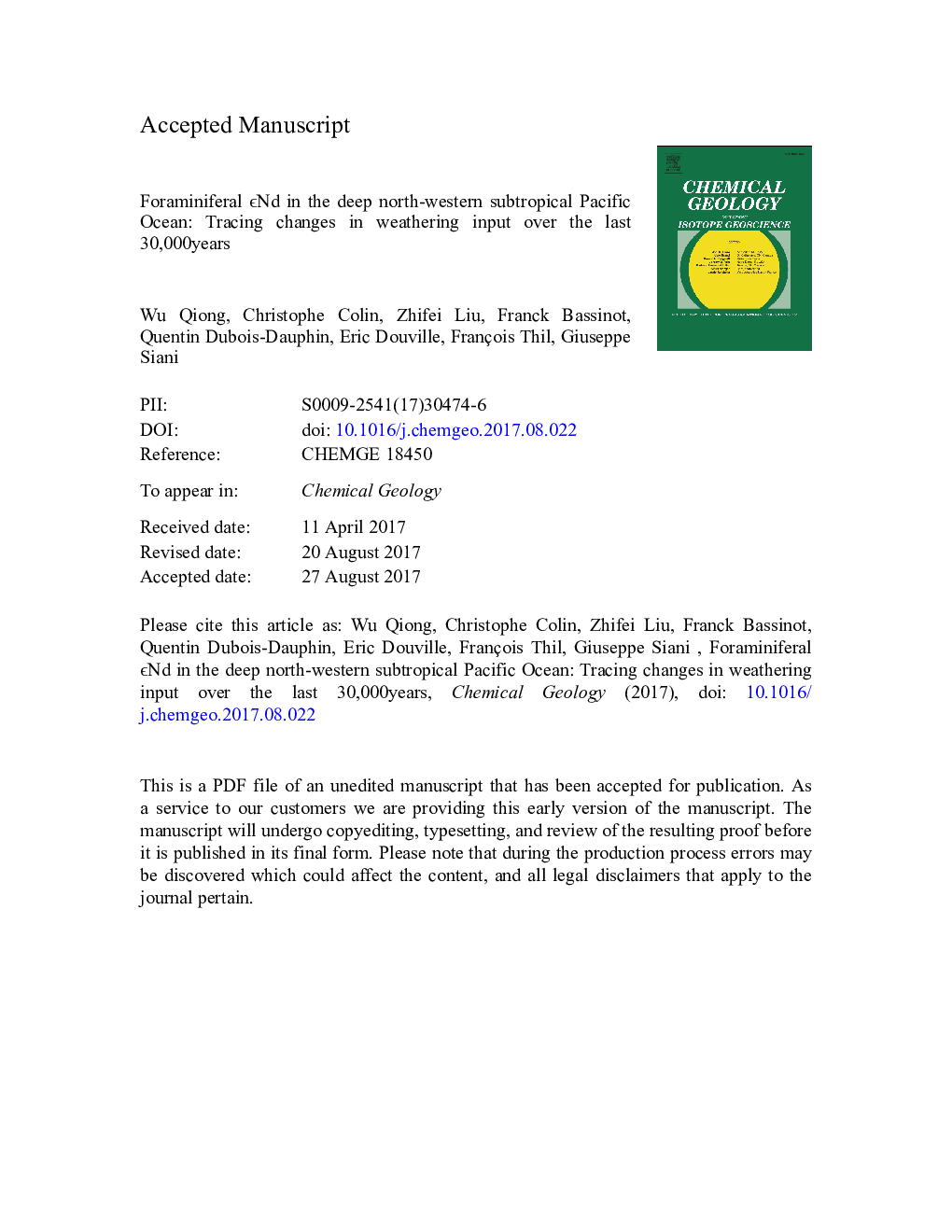| کد مقاله | کد نشریه | سال انتشار | مقاله انگلیسی | نسخه تمام متن |
|---|---|---|---|---|
| 5782596 | 1637504 | 2017 | 45 صفحه PDF | دانلود رایگان |
عنوان انگلیسی مقاله ISI
Foraminiferal εNd in the deep north-western subtropical Pacific Ocean: Tracing changes in weathering input over the last 30,000 years
دانلود مقاله + سفارش ترجمه
دانلود مقاله ISI انگلیسی
رایگان برای ایرانیان
کلمات کلیدی
موضوعات مرتبط
مهندسی و علوم پایه
علوم زمین و سیارات
ژئوشیمی و پترولوژی
پیش نمایش صفحه اول مقاله

چکیده انگلیسی
This study focuses on the neodymium isotopic composition (εNd) of mixed planktonic foraminifera species in sediment cores collected on the north-western margin of the South China Sea (SCS) and in the western equatorial Pacific. The aim was to identify temporal changes in the εNd of the Upper Circumpolar Deep Water (UCDW) during its northward penetration in the western subtropical Pacific and to re-evaluate the significance of deep-water εNd changes at the northern margin of the SCS over the past 25 kyr. The past seawater εNd record derived from sediments of the subtropical western Pacific displays a narrow range from â 2.9 ± 0.3 to â 1.6 ± 0.4. This suggests that the εNd of the UCDW is greatly modified during its northward penetration through the process of boundary exchange along the western volcanic margin of the South Pacific and that the unradiogenic εNd signature of the UCDW observed in the South Pacific (about â 6) has not been propagated beyond the equatorial Pacific, at least not over the last 25 kyr. Seawater εNd values obtained from the northern SCS display large variations with values that are lower (â 6.8 ± 0.3 to â 5.6 ± 0.2) for the last glacial period than for the late Holocene (â 5.7 ± 0.3 to â 4.1 ± 0.2). Such glacial εNd cannot be attributed to a higher proportion of southern-sourced water (SSW) as εNd values of the UCDW in the equatorial western Pacific are more radiogenic than those observed in the SCS. The evolution of the seawater εNd values of the northern SCS during the last glacial period and the last climatic transition is coeval with variations in the contribution of sediments from the Pearl River. The low sea level stand of the last glacial period resulted in a more proximal position of the Pearl River mouth relative to core MD05-2904, which a higher input of freshwater and, in particular, detrital sedimentary particles originating from the Pearl River that partially dissolved during sinking led to a decrease in the seawater εNd along the north-western margin of the SCS. Enhanced rainfalls associated with intensified monsoon and more frequent typhoon activities during the early Holocene Climatic Optimum (from 9 to 7 cal kyr BP) are linked to a decrease in sea surface salinity (lower δ18O values of planktonic foraminifera) and a decrease in εNd values (â 6.2 ± 0.3) induced by lithogenic Nd input from pronounced freshwater and sediment discharge from distal rivers.
ناشر
Database: Elsevier - ScienceDirect (ساینس دایرکت)
Journal: Chemical Geology - Volume 470, 20 October 2017, Pages 55-66
Journal: Chemical Geology - Volume 470, 20 October 2017, Pages 55-66
نویسندگان
Qiong Wu, Christophe Colin, Zhifei Liu, Franck Bassinot, Quentin Dubois-Dauphin, Eric Douville, François Thil, Giuseppe Siani,